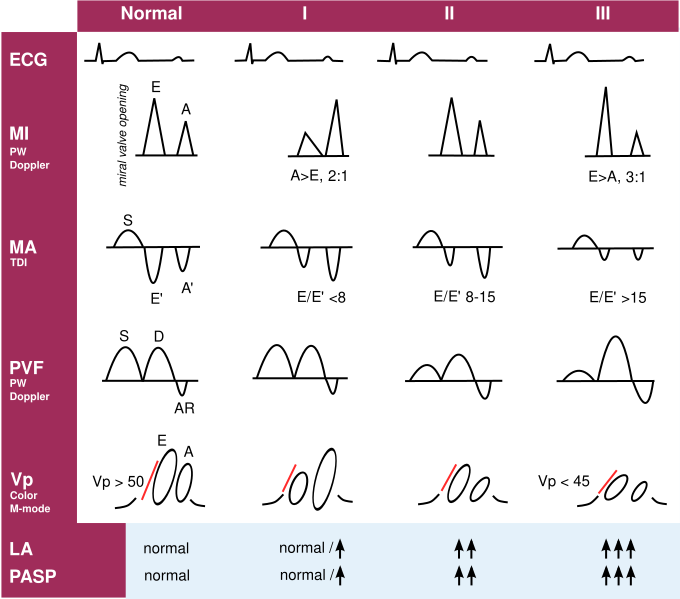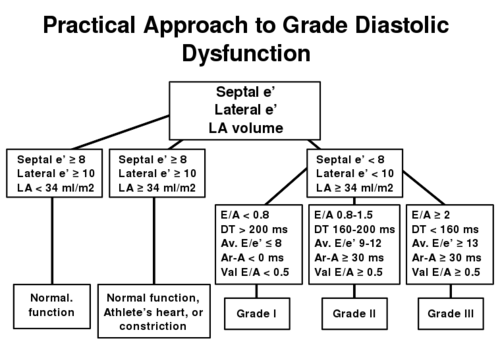Diastolic Function
Jump to navigation
Jump to search
The Left Ventricle
There is still much uncertainty about the pathophysiology of diastolic heart failure, effective treatment has not surfaced yet while it has a similar high mortality and morbidity rate when compared to systolic heart failure. One of the characteristics of diastolic heart failure is an increased LV diastolic stiffness. There are several important measurements echocardiographic measurement to estimate cardiac diastolic performance.
Left ventricular diastolic function
Normal Values diastolic parameters | |||||
|---|---|---|---|---|---|
| Measurement | Age group (y) | ||||
| 16-20 | 21-40 | 41-60 | >60 | ||
| IVRT (ms) | 50 ± 9 (32-68) | 67 ± 8 (51-83) | 74 ± 7 (60-88) | 87 ± 7 (73-101) | |
| E/A ratio | 1.88 ± 0.45 (0.98-2.78) | 1.53 ± 0.40 (0.73-2.33) | 1.28 ± 0.25 (0.78-1.78) | 0.96 ± 0.18 (0.6-1.32) | |
| DT (ms) | 142 ± 19 (104-180) | 166 ± 14 (138-194) | 181 ± 19 (143-219) | 200 ± 29 (142-258) | |
| A duration (ms) | 113 ± 17 (79-147) | 127 ± 13 (101-153) | 133 ± 13 (107-159) | 138 ± 19 (100-176) | |
| PV S/D ratio | 0.82 ± 0.18 (0.46-1.18) | 0.98 ± 0.32 (0.34-1.62) | 1.21 ± 0.2 (0.81-1.61) | 1.39 ± 0.47 (0.45-2.33) | |
| PV Ar (cm/s) | 16 ± 10 (1-36) | 21 ± 8 (5-37) | 23 ± 3 (17-29) | 25 ± 9 (11-39) | |
| PV Ar duration (ms) | 66 ± 39 (1-144) | 96 ± 33 (30-162) | 112 ± 15 (82-142) | 113 ± 30 (53-173) | |
| Septal e´ (cm/s) | 14.9 ± 2.4 (10.1-19.7) | 15.5 ± 2.7 (10.1-20.9) | 12.2 ± 2.3 (7.6-16.8) | 10.4 ± 2.1 (6.2-14.6) | |
| Septal e´/a´ ratio | 2.4* | 1.6 ± 0.5 (0.6-2.6) | 1.1 ± 0.3 (0.5-1.7) | 0.85 ± 0.2 (0.45-1.25) | |
| Lateral e´ (cm/s) | 20.6 ± 3.8 (13-28.2) | 19.8 ± 2.9 (14-25.6) | 16.1 ± 2.3 (11.5-20.7) | 12.9 ± 3.5 (5.9-19.9) | |
| Lateral e´/a´ ratio | 3.1* | 1.9 ± 0.6 (0.7-3.1) | 1.5 ± 0.5 (0.5-2.5) | 0.9 ± 0.4 (0.1-1.7) | |
| |||||
Schematic diastolic filling patterns |
|---|
| A patient with dyspnea, preserved systolic LV function, dilated left atrium and elevated pulmonary artery systolic pressure, without any significant mitral valve disease that could explain these findings, is the patient that requires an intensified search for diastolic LV dysfunction. |

|
| I: impaired relaxation, II: moderate diastolic dysfunction (pseudonormal), III: restrictive left ventricular filling (impaired LV compliance), ECG: electrocardiogram, MI: mitral inflow, MA: mitral annular velocities, PVF: pulmonary venous flow, Vp: velocity of flow progression, LA: left atrium, PASP: pulmonary artery systolic pressure.[2]
Click here for animation on diastolic dysfunction |
Diastolic function flowchart [1] |
|---|

|